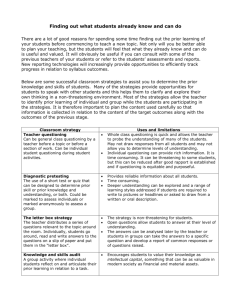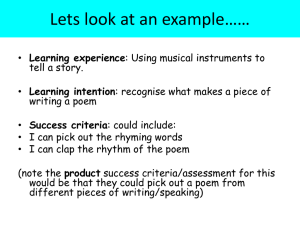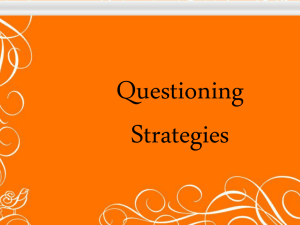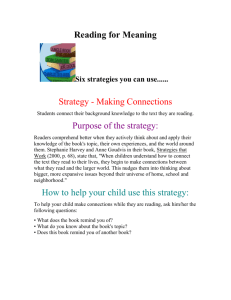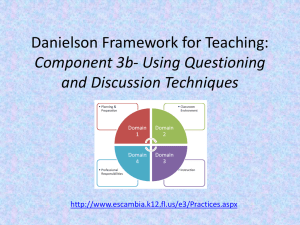PPT - AchieveNJ.org
advertisement
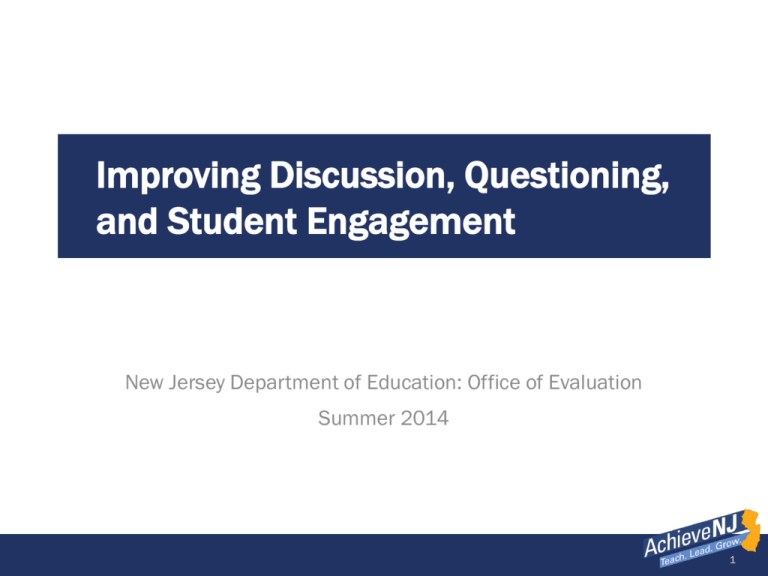
Improving Discussion, Questioning, and Student Engagement New Jersey Department of Education: Office of Evaluation Summer 2014 1 Objectives • Identify and apply discussion and questioning techniques in practice • Recognize and integrate strategies for increasing student engagement in practice • Self-assess and develop action steps for implementation 2 Agenda • Welcome and introductions • Overview of questioning and discussion techniques • Questioning activity and debrief • Break • Overview of student engagement techniques • Student engagement activity and debrief • Reminder of AchieveNJ resources and materials 3 Norms and Materials Norms • Be engaged, attentive, and respectful Materials • Utilize the supporting materials – Keep p. 9 handy throughout the session – Electronic versions of all materials are available on the AchieveNJ website 4 Why Questioning and Discussion? Engaging students in higher order questioning and discussion: 1 •Is a fundamental part of teaching and learning 2 •Allows students to engage with complex concepts 3 •Further refines students’ abilities to solve problems and think critically 5 Questioning Connects Effective questioning allows educators to connect the main elements of their practice. Assessment Q’s Instruction Standards: NJCCCS/ Common Core 6 Questioning and Discussion in Observations Questioning and discussion are essential elements of all state-approved teacher practice instruments. Danielson Marshall Marzano McREL Stronge 3b A-c,d,g C-c,g,h D-c Domain 1: DQ 2,3,4,5 Standard IV Performance Standard 2,3,4 This crosswalk includes the most commonly selected (but not all) NJDOEapproved instruments. 7 Keys for Questioning Use clear protocols Allow all students to access/ respond to questions Foster studentcreated questions When planning… Apply range of “Depth of Knowledge” (DOK) Provide ample wait time 8 Use Clear Protocols Take time to think Clear protocols have explicit steps to assure the right outcomes. This protocol is one approach. Answer and discuss respectfully Talk on topic/listen actively Ask clarifying or extension questions Give others a chance; invite others to respond to you Build on what the person said Protocols . . . . 9 Classroom Questioning and Discussion Protocol Activity Instructions • Watch the video “Analyzing Text as a Group Lesson” • Complete the worksheet. (p. 1) • Indicate evidence of a clear classroom protocol in Ms. Brewer’s classroom. – How does Ms. Brewer apply her protocol for questioning and discussion effectively? • Think-Pair-Share – As the pairs share, infuse some of the protocol components. (p. 9) (e.g. Ask clarifying or extension questions, build on what the person said) Protocols . . . . 10 Apply Range of “Depth of Knowledge” What is it? Why is it? •The span of cognitive rigor that aligns to what students are expected to know and do as stated in the state standards •Students are asked to access information at different cognitive levels What does it accomplish? •Ensures that the level of student demonstration matches the required rigor of the standards . . DOK . . 11 Activity: Think-Square-Share Instructions • Convene in groups of 4. • Select which Depth of Knowledge Level each person will be examining. (pp. 2-3) • Take 5 minutes to carefully read and comprehend your DOK Level. • Watch the Video: “Developing Higher Level Understanding Through Questioning” – Indicate on your worksheet when you see evidence of your DOK level in the video. • Discuss your findings with those around you. • As a group, rank the DOK levels according to how present they were in the video (1-4 with 1 being the highest). (p. 4) • Provide a rationale for your analysis. • Report out to the whole group using the protocol. (p. 9) . . DOK . . 12 Provide Ample Wait Time Strategy Video: Wait Time 1 & 2 Encourages deeper thinking Allows wholeclass extended thinking Invites more students to participate . . Waiting 3-5 seconds before and after an answer is given: Promotes active listening Enables studentconstructed questions/ clarifications . . Wait time 13 Foster Student-Created Questions Support for student-created questions. . . Fosters academic independence Allows students to stretch their range of complexity . . Studentcreated questions Enables students to make substantive contributions to collaborative groups Invites students to seek clarifications Serves as an informal assessment lever . . 14 Resources for Student-Created Questions Instructions • Watch how Ms. Francisco utilizes resources to enable her students to create higher order questions: • Developing Better Questions Video Ms. Francisco’s Resources: Bloom's Taxonomy Verb Starters Costa's Levels of Questioning The Frayer Model . . Studentcreated questions . . 15 Allow All Students to Access/Respond to Questions Promotes risktaking when offering new ideas Invites active Thinking Promotes shared and collaborative accountability for learning Allowing all students access/ respond to questions Provides for formative assessment . Access questions . . . 16 Sample Strategies that Allow All Students to Participate: • Turn and Talk • Voting • Think-Pair-Share • Ranking – Think-Pair-Square – Think-Square-Share – (see pg. #24) • Slate/Whiteboard answers . Access questions . . . 17 17 Review-Revisit-Respond Review your notes from the videos Revisit the keys for questioning Respond: How are the key components intertwined? Use The Sticky-Notes to write your answer as an exit-ticket to your break. 18 10-Minute BREAK 19 Why Student Engagement? The engaged student: 1 •Earns higher grades 2 •Persists on tasks 3 •Can set and meet personal goals 4 •Expects success 5 •Reports a greater sense of belonging 6 •Values educational outcomes (Christenson, et al., 2008; National Research Council, 2004) 20 Observation Instrument Crosswalk Student engagement is an essential element of all state-approved teacher practice instruments. Danielson Marshall Marzano McREL Stronge 3c A.G C.G DQ: 5 Standard IV Performance Standard 3 This crosswalk includes the most commonly selected (but not all) NJDOEapproved instruments. 21 Keys to Student Engagement Exhibit high energy Connect to student interests Use structured pacing Student engagement Invite curiosity Promote problem solving, choice, depth 22 Exhibit High Energy for Student Engagement High energy tools Ideas to implement Enthusiasm about material •Revise units of study that are least interesting to you or students •Problematize the content to have students uncover and discover instead of “covering” Movement to lift energy and deepen understanding •Foster opportunities for movement in the classroom •Utilize movement/ proximity to demonstrate enthusiasm and management Verbal and non-verbal signs to reinforce attention and energy •Differentiate vocal intonation and inflection •Hand signals to check for understanding or reinforcement High energy . . . . . 23 Think-Square-Share: High Energy Instructions • Turn to your group – The 4-person square from earlier • Discuss additional ways to activate and demonstrate high energy in classrooms • Share with the whole group while integrating the elements of the questioning and discussion protocol. (p. 9) – (e.g. Ask clarifying or extension questions, build on what the person said) High energy . . . . . 24 Use Structured Pacing Strategies for structured pacing Create a sense of urgency •Use a timer •Plan visual or verbal cues Make goals clear •Post goals and objectives •Check for understanding Plan smooth transitions •Choreograph your classroom •Manage transitions Have materials ready •Establish a routine pattern for where consistent resources are located •Pre-set unique resources needed for a specific lesson Present instructions visually •Utilize board space to prominently post instructions •Reinforce instructions on handouts Check for understanding •Cup Strategy •Thumbs-up, down, side . . Pacing . . . 25 Activity: Connecting to Questioning Instructions • Turn and Talk - Discuss the following prompt with your partner: – How do the following components of student engagement connect with effective questioning? • Promote problem solving, choice, depth • Invite curiosity • Connects to student interest • Report out – As the pairs share, infuse some of the protocol components. (p. 9) (e.g. Ask clarifying or extension questions, build on what the person said) . . Student interest . Curiosity Problemsolving 26 Activity: Student Engagement Instructions: • Watch the video “Writing Recipe in an ELL Class”. • Record evidence that shows use of the keys to student engagement. (p. 5) • Think-Pair-Share – Which keys to student engagement were the most prevalent? • Report to the whole group while integrating the elements of the questioning and discussion protocol. (p. 9) – (e.g. Ask clarifying or extension questions, build on what the person said) 27 Activity: Student Engagement Instructions: • Watch the Video “Visualizing Number Combinations”. • Record evidence that shows use of the keys to student engagement. (p. 6) • Think-Pair-Share – Which keys to student engagement are most prevalent? • Report to the whole group while integrating the elements of the questioning and discussion protocol. 28 Activity: Compare/Contrast Instructions: • Think-Square-Share • Convene into a group of 4. • Compare and contrast the keys to student engagement between the 2 videos. (p. 7) • How do the teachers use similar and different approaches to foster student engagement? • Report to the whole group while integrating the elements of the questioning and discussion protocol. (p. 9) • BONUS QUESTION: Where does the complete student engagement activity connect with the Depth of Knowledge wheel? 29 Self-Assessment/ Action Steps Instructions: • Individually complete the Self-Assessment. (p. 8) • For elements indicated as strengths, include specific action steps regarding how you could help others improve. • For elements indicated as weaknesses, include specific action steps in how you could help yourself improve. 30 SGO 2.0: From Compliance to Quality Check out the AchieveNJ website for – Updated Guidance, SGO Exemplars, Training Modules – http://www.state.nj.us/education/AchieveNJ/teacher/objectives.shtml In-person SGO 2.0 workshops will resume in late summer and early fall. – http://www.state.nj.us/education/AchieveNJ/resources/events.shtml Location Time Registration Morris Union Jointure Commission New Providence 9:00 am – 12:00 pm Register August 11, 2014 12:30 pm – 3:30 pm Register August 12, 2014 Stockton College Galloway Township 9:00 am – 12:00 pm Register 12:30 pm – 3:30 pm Register September 19, 2014 EIRC/LRC-South Mullica Hill 9:00 am – 12:00 pm Register 12:30 pm – 3:30 pm Register September 22, 2014 Raritan Valley Community College Branchburg 9:00 am – 12:00 pm Register 12:30 pm – 3:30 pm Register September 29, 2014 NJPSA Monroe Township 9:00 am – 12:00 pm Register 12:30 pm – 3:30 pm Register Date 31 AchieveNJ Resources Website resources most relevant to teachers include: • Main website: http://www.nj.gov/education/AchieveNJ/ • Teacher evaluation page: http://www.nj.gov/education/AchieveNJ/teacher/ • SGO Page: http://www.nj.gov/education/AchieveNJ/teacher/objectives.shtml • SGP Page http://www.nj.gov/education/AchieveNJ/teacher/percentile.shtml • Resource Library: http://www.nj.gov/education/AchieveNJ/resources/ Please visit our website periodically. New resources are added monthly. 32 Thank You! Questions or Feedback? Office of Evaluation educatorevaluation@doe.state.nj.us (609)777-3788 33
